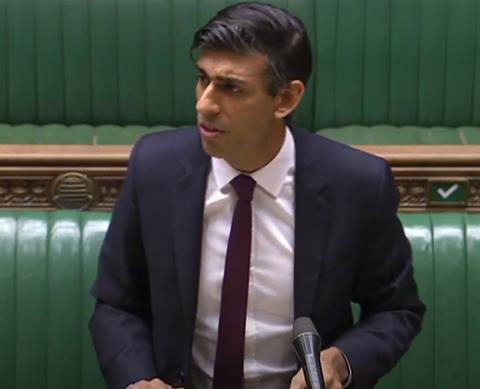Announcement follows demands from RIBA president for more help
The government has heeded calls from the RIBA and others and doubled the amount of financial support given to self-employed workers during November as the profession braces for a second national lockdown.
Chancellor Rishi Sunak announced that self-employed workers would be able to claim grants worth up to 80% of trading profits this month, two weeks after he reduced the support offered by the scheme to 40%.

It comes three days before England is set to be plunged back into a national lockdown lasting at least until December 2, although the government has encouraged construction sites to stay open through the restrictions.
The boosted support offered in the third tranche of the self-employed income support scheme (SEISS) brings it up to the level of the first two tranches, which both offered 80% of profits. Sunak had announced on 22 October that the third tranche, which will run from this month to January, would only offer 40% of profits.
The upgrading of support for the self-employed follows the prime minister’s announcement on Saturday that the government’s furlough scheme would be extended into December to support firms hit by the impending lockdown.

The scheme, which saw £37.5bn shelled out by the government for the period up to 31 August, had been due to end on 31 October, the same day as Johnson’s announcement.
Sunak’s announcement came after a warning from RIBA president Alan Jones yesterday that extra support needed to be given to self-employed people in the profession.
He also said more should be done to help defer tax repayments.
Jones said: “While we welcome the extension of that scheme for a further month, we remain concerned about the lack of uprated support for self-employed workers and are calling for greater flexibility on existing tax bill repayments.”
PRP senior partner Brendan Kilpatrick said: “The furlough extension is of little importance as decisions have already been made by many practices on how to deal with the commercial downtown.

“The new lockdown is different from the first because we have an advisedly finite period of lockdown to deal with, we know what to expect, and we know that construction sites can carry on which is incredibly important in maintaining confidence and preventing blockages in the housing market. We can therefore weather this difficult period, into January if necessary, and look forward to 2021 to get covid behind us.”
Kilpatrick has previously argued that some firms which rushed to furlough staff acted irresponsiblly, putting other jobs in the supply chain at risk.
>> Also read: Architect condemns clients who ‘abandoned ship at first sign of iceberg’
The construction industry is the sector with the highest proportion of claims for the SEISS and has the highest number of eligible individuals.
HMRC data shows that the sector accounted for more than 40% of all claims to both tranches of the SEISS, receiving £5.5bn of the £13.5bn given by the government to self-employed workers since the scheme opened on May 13.
Those working in construction accounted for the highest proportion of claims in every country and region of the UK. London has seen the highest share, with 40% of claims for the scheme in the capital coming from construction workers. The claims of those working in construction also had the second highest average value at £3,100 per claimant, behind financial and insurance activities on £3,600 per claimant.
While construction sites will be able to stay open, all non-essential shops, restaurants, pubs and leisure facilities will close during the new lockdown period.
















No comments yet